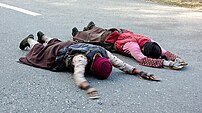 I received an advance copy of Ready to Run by Dr. Kelly Starrett to read and review here. Getting our bodies to a point of injury reduction and improved mobility isn’t an easy process but he lays out his philosophy in a pretty easy to read and understand format, that includes lots of pictures! This is not your typical running book that helps you fix a problem with your mechanics to make you a better runner. Starrett takes a pretty broad view of running. He has created a plan/system that looks at 12 “standards” that make us better runners. I think it is a valuable book for runners of all levels. Some runners may be turned off by his references to Crossfit and terms that are thought of as being Crossfit related. But the book is clearly for any runner and not just the “crazy” Crossfit type athlete.
I received an advance copy of Ready to Run by Dr. Kelly Starrett to read and review here. Getting our bodies to a point of injury reduction and improved mobility isn’t an easy process but he lays out his philosophy in a pretty easy to read and understand format, that includes lots of pictures! This is not your typical running book that helps you fix a problem with your mechanics to make you a better runner. Starrett takes a pretty broad view of running. He has created a plan/system that looks at 12 “standards” that make us better runners. I think it is a valuable book for runners of all levels. Some runners may be turned off by his references to Crossfit and terms that are thought of as being Crossfit related. But the book is clearly for any runner and not just the “crazy” Crossfit type athlete.
The book is broken into 4 sections. Part 1 is an introduction to his philosophy and some of his basic ideas about runners and running. Part 2 is a more in-depth look at the 12 standards that are at the heart of Ready to Run. Each standard has its own chapter in which Starrett goes in-depth about what that standard means and how to reach it. Part 3 is a detailed explanation of each mobility exercise mentioned throughout the book. Both Part 2 and Part 3 include a lot of pictures of the movements and positions to help the reader/athlete ensure they are performing the mobilization correctly. In Part 4 Starrett highlights several major running injuries and details which mobilizations would be the most helpful to complete to help you overcome it.
Here is a quote from the preface of the book that I think really sums it up:
The ideas and framework that Kelly sets forth in this book are not just about preventing and dealing with injuries. A tremendous bonus to solving injury-related problems with solutions based on mechanics, position, and mobility is that it also frees up extra performance that you may not have known you had. The same tissue restrictions that are causing your knee pain may also be robbing you of some hidden flow of power output. By improving the positions you adopt and the health of the tissues involved and installing normal range of motion in your joints, you may find additional energy to help you run faster and longer.
The 12 chapters highlighting the 12 Standards are broken down into a few sections. Each standard is listed as a question; “Can you squat correctly” is the 4th Standard. Following the question is a brief introduction of the standard followed by why it is important or why you should be motivated to care about the standard. The chapter also includes a list of mobility exercises to help you reach the standard, a more in-depth look at why the standard is important, pictures and steps to check to see if you meet the standard, sometimes a picture of bad form, and finally a section called Runner to Runner from co-author T.J. Murphy who shares his experience related to the standard.
The 12 standards include some common sense standards (and practical tips) like – hydration, warming up, and getting up and walking during the work day. They also include some that might be seen as more controversial such as wearing compression gear or neutral shoes (he does recommend gradually working down if you aren’t already wearing neutral). From my experience as a runner I think working towards most of the standards definitely won’t hurt! After reading the book I’ve already noticed myself occasionally looking at my fight while standing around and putting them into a neutral position.
The standards are the meat of what it means to be “ready to run” but the bulk of the book is really about the mobilization exercises. Throughout Part 3 are written explanations as well as high quality pictures so that the reader can read and see what is supposed to happen. Starrett also highlights some tools that are useful for the home gym. He highlights some cheap tools like a lacrosse (lax) ball and then some higher end equipment as well.
I think we all know the value of being more supple or flexible and the ideas of improved mechanics. Ready to Run actually lays out the tools and tips to get there. The book doesn’t offer a specific training plan laid out over time, but it can allow you to build around your specific needs. Starrett has a lot of resources (some free) available on his website Mobility WOD.
Ready to Run is available from Amazon in paperback and Kindle editions.
Here is a video trailer:

![Reblog this post [with Zemanta]](https://i0.wp.com/img.zemanta.com/reblog_e.png?w=625)


